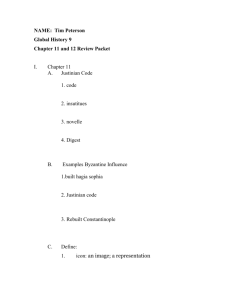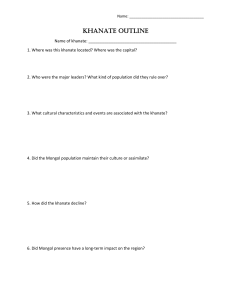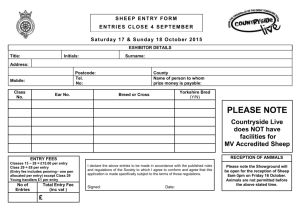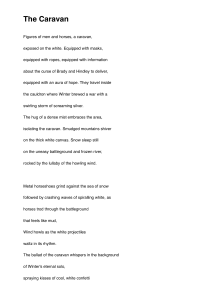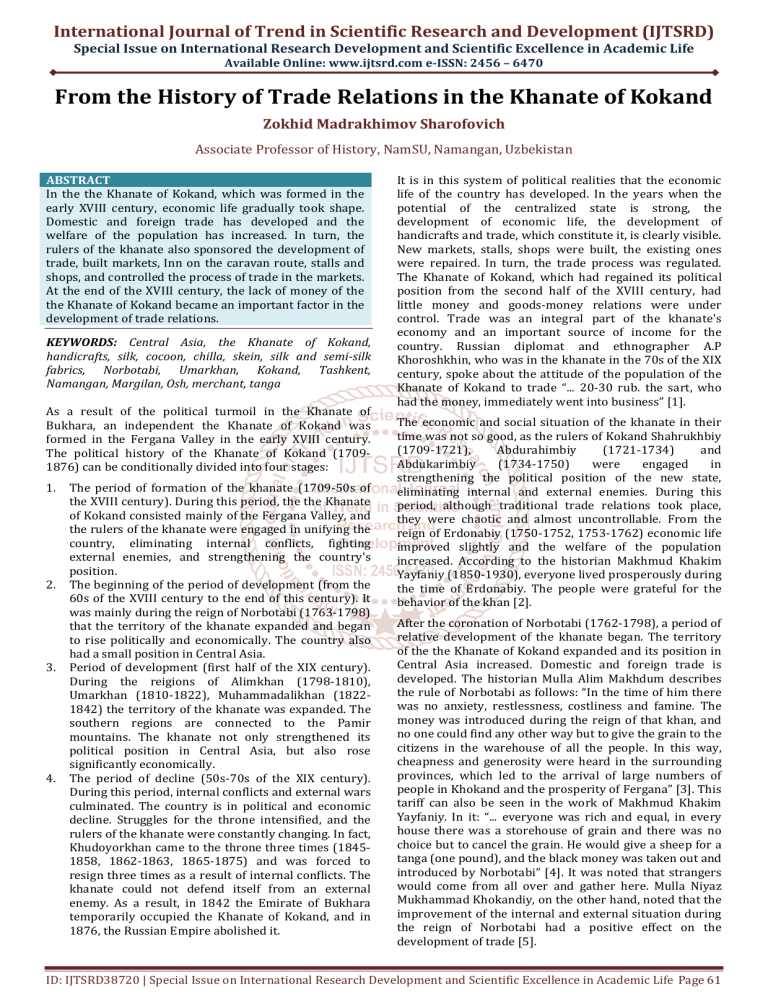
International Journal of Trend in Scientific Research and Development (IJTSRD) Special Issue on International Research Development and Scientific Excellence in Academic Life Available Online: www.ijtsrd.com e-ISSN: 2456 – 6470 From the History of Trade Relations in the Khanate of Kokand Zokhid Madrakhimov Sharofovich Associate Professor of History, NamSU, Namangan, Uzbekistan ABSTRACT In the the Khanate of Kokand, which was formed in the early XVIII century, economic life gradually took shape. Domestic and foreign trade has developed and the welfare of the population has increased. In turn, the rulers of the khanate also sponsored the development of trade, built markets, Inn on the caravan route, stalls and shops, and controlled the process of trade in the markets. At the end of the XVIII century, the lack of money of the the Khanate of Kokand became an important factor in the development of trade relations. KEYWORDS: Central Asia, the Khanate of Kokand, handicrafts, silk, cocoon, chilla, skein, silk and semi-silk fabrics, Norbotabi, Umarkhan, Kokand, Tashkent, Namangan, Margilan, Osh, merchant, tanga As a result of the political turmoil in the Khanate of Bukhara, an independent the Khanate of Kokand was formed in the Fergana Valley in the early XVIII century. The political history of the Khanate of Kokand (17091876) can be conditionally divided into four stages: 1. 2. 3. 4. The period of formation of the khanate (1709-50s of the XVIII century). During this period, the the Khanate of Kokand consisted mainly of the Fergana Valley, and the rulers of the khanate were engaged in unifying the country, eliminating internal conflicts, fighting external enemies, and strengthening the country's position. The beginning of the period of development (from the 60s of the XVIII century to the end of this century). It was mainly during the reign of Norbotabi (1763-1798) that the territory of the khanate expanded and began to rise politically and economically. The country also had a small position in Central Asia. Period of development (first half of the XIX century). During the reigions of Alimkhan (1798-1810), Umarkhan (1810-1822), Muhammadalikhan (18221842) the territory of the khanate was expanded. The southern regions are connected to the Pamir mountains. The khanate not only strengthened its political position in Central Asia, but also rose significantly economically. The period of decline (50s-70s of the XIX century). During this period, internal conflicts and external wars culminated. The country is in political and economic decline. Struggles for the throne intensified, and the rulers of the khanate were constantly changing. In fact, Khudoyorkhan came to the throne three times (18451858, 1862-1863, 1865-1875) and was forced to resign three times as a result of internal conflicts. The khanate could not defend itself from an external enemy. As a result, in 1842 the Emirate of Bukhara temporarily occupied the Khanate of Kokand, and in 1876, the Russian Empire abolished it. It is in this system of political realities that the economic life of the country has developed. In the years when the potential of the centralized state is strong, the development of economic life, the development of handicrafts and trade, which constitute it, is clearly visible. New markets, stalls, shops were built, the existing ones were repaired. In turn, the trade process was regulated. The Khanate of Kokand, which had regained its political position from the second half of the XVIII century, had little money and goods-money relations were under control. Trade was an integral part of the khanate's economy and an important source of income for the country. Russian diplomat and ethnographer A.P Khoroshkhin, who was in the khanate in the 70s of the XIX century, spoke about the attitude of the population of the Khanate of Kokand to trade “... 20-30 rub. the sart, who had the money, immediately went into business” [1]. The economic and social situation of the khanate in their time was not so good, as the rulers of Kokand Shahrukhbiy (1709-1721), Abdurahimbiy (1721-1734) and Abdukarimbiy (1734-1750) were engaged in strengthening the political position of the new state, eliminating internal and external enemies. During this period, although traditional trade relations took place, they were chaotic and almost uncontrollable. From the reign of Erdonabiy (1750-1752, 1753-1762) economic life improved slightly and the welfare of the population increased. According to the historian Makhmud Khakim Yayfaniy (1850-1930), everyone lived prosperously during the time of Erdonabiy. The people were grateful for the behavior of the khan [2]. After the coronation of Norbotabi (1762-1798), a period of relative development of the khanate began. The territory of the the Khanate of Kokand expanded and its position in Central Asia increased. Domestic and foreign trade is developed. The historian Mulla Alim Makhdum describes the rule of Norbotabi as follows: “In the time of him there was no anxiety, restlessness, costliness and famine. The money was introduced during the reign of that khan, and no one could find any other way but to give the grain to the citizens in the warehouse of all the people. In this way, cheapness and generosity were heard in the surrounding provinces, which led to the arrival of large numbers of people in Khokand and the prosperity of Fergana” [3]. This tariff can also be seen in the work of Makhmud Khakim Yayfaniy. In it: “... everyone was rich and equal, in every house there was a storehouse of grain and there was no choice but to cancel the grain. He would give a sheep for a tanga (one pound), and the black money was taken out and introduced by Norbotabi” [4]. It was noted that strangers would come from all over and gather here. Mulla Niyaz Mukhammad Khokandiy, on the other hand, noted that the improvement of the internal and external situation during the reign of Norbotabi had a positive effect on the development of trade [5]. ID: IJTSRD38720 | Special Issue on International Research Development and Scientific Excellence in Academic Life Page 61 International Journal of Trend in Scientific Research and Development (IJTSRD) @ www.ijtsrd.com eISSN: 2456-6470 During the reigns of Alimkhan (1798-1810), Umarkhan (1810-1822) and Muhammadalikhan (1822-1842) the development of the Khanate of Kokand reached a new stage. The Khanate became one of the largest states in Central Asia. The economy also grew, and the development of domestic and foreign trade had little effect on the wellbeing of the population. The shops in the markets of the cities of Kokand are divided into three types: those belonging to the ruling dynasty and those belonging to various officials, private and Waqf shops. According to archival data, on the eve of the end of the khanate, there were 1911 shops in the markets of Kokand, of which 599 belonged to the ruler, 1312 were private shops [11]. The urban and rural population exported agricultural and handicraft products to the country's markets, while the mountainous population and nomadic pastoralists exported livestock and livestock products. Local traders went to the remote villages of the khanate and bought the products grown or prepared in that area at low prices, wholesale, and brought them to the big city markets. In turn, there were traders who bought the goods of artisans, and a few who went to the market, the city to the city, the village to the village. According to the Russian orientalist N.Pantusov, during the reign of Khudoyorkhan most of the inns on the caravan route, shops, baths and other commercial buildings in the capital were not taxed. This is because most of them belonged to the khan or were considered the property of the Waqf [12]. In particular, during this period, 5 out of 10 inns on the caravan routein the city belonged to the khan [13]. The shops were leased to traders and rent was paid from them in the prescribed manner. In 1874, the khan's treasury received 2131 gold coins from 575 shops in Kokand [14]. Mukhammad Aziz Margilaniy, a historian of luxury and cheapness in the khanate, “...said that during the time of the Kokand khans, there was little money and cheapness among the people of Fergana. In summer, a cart sells for two and a half to five tangas, a cart sells melons for 3,5 tangas, a basket of apricots for three tangas and 1 tanga, a chaksa (a unit of weight equal to 1/3 pud per chaksa. One pud is 16,3 kg.) the price of rice ranges from one to two tangas, a pud of fresh flour costs more than a tanga, a pistachio costs from fifty paysa (a paysa is given here instead of a small tanga), a pud of pure yellow nuts costs a hundred paysa, some apricots, carrots and onions. You could buy one pul to six puls, you could barely carry it, you could give 40 chaqas (penny) for a tanga, you could put that money in your wallet and go to the market and spend it all night, and it would all come back without spending it, and again ... citizens could collect royalties in a short time. He wrote that they were tortured without giving” [6]. In the large cities of the khanate there was a market two or three times a week, in smaller towns and large villages, and once in places where several small villages adjacent to each other were connected. The city of Kokand was the largest economic center of the khanate and played an important role in domestic trade. According to Philip Nazarov, a Russian diplomat and orientalist who was in the khanate from 1813 to 1814, there was a three market which was made of stone, in the center of Kokand, with a market twice a week [7]. N.I. Potanin, a Russian orientalist who visited Kokand in 1830, pointed out that there were six markets in the capital of khanate [8]. According to the anonymous author, in the 1840s, 2 out of 6 markets in Kokand were traded by local traders and 4 by traders from different regions [9]. Some of the Kokand markets were covered with pineapples, which existed in Central Asia, and were also suitable for the rainy season. Kokand market was one of the best markets in Central Asia after the market of Bukhara. Typical of Central Asian cities, the main market of Kokand is located in the center of the city, at the junction of various streets and is known as the big Market. The Russian orientalist A.L Kun noted that when he came to the capital in 1875, there were about 2,000 shops in this market. The main market is divided into separate outlets or small markets, depending on the type of product [10]. The largest trade in the markets of the the Khanate of Kokand took place in the open market areas, while the Inns on the caravan route traded in relatively expensive goods, foreign goods and wholesale goods. The Kokand markets were crowded with traders and buyers, with about 600 traders in the main market engaged in smallscale trade alone [15]. In the middle of the XIX century, when the economic life of the khanate reached a more moderate level, the market in Kokand lasted three days a week on Wednesdays, Thursdays and Sundays from morning to evening. Wednesday is the main market day, and traders from different cities of the khanate and neighboring areas came to the market on this day. The locals brought handicrafts and agricultural products from the suburbs to the Kokand markets. Also, a variety of products made and grown in different regions of the khanate were sold in Kokand markets. The Kokand market was the main distribution center for goods entering the Fergana Valley from neighboring areas, and traders from different parts of the khanate could be seen in its markets. Located in Tashkent, one of the largest and richest markets of the the Khanate of Kokand, it was famous not only for its local handicrafts, farming, and horticultural products, but also for its market of goods from Russia and the Kazakh steppes. In the XVIII and XIX centuries, there were few markets in the Sebzor, Kokcha, Beshyogoch, and Shaykhantakhur districts of Tashkent. The largest market was located in the city center, at the intersection of town’s part, and was called Joba (or Jova) market. According to historian Mukhammad Salikh, “...the market stalls continue to the confectionery shop in Chorsu. During the month of Ramadan, there is a market here at night, and people trade and have fun” [16]. At the beginning of the XIX century, there were more than 3,000 shops in the Joba market (now Chorsu), including shops in the main rows and Inn on the caravan route. In the 60s of the XIX century, the market was 400 sarjins (1 sarjin- length of the earth, equals 2,13 meters) and 100 sarjins wide, with 16 inns on the caravan routeand 2,400 shops. The number of shops in the city reached 4,548 [17]. In the 1960s, the rent for shops in the Tashkent market was 2 to 4 gold coins a year [18]. ID: IJTSRD38720 | Special Issue on International Research Development and Scientific Excellence in Academic Life Page 62 International Journal of Trend in Scientific Research and Development (IJTSRD) @ www.ijtsrd.com eISSN: 2456-6470 The central market in Tashkent was also divided into rows according to the type of product, and in the 1960s the number of rows was about 40 [19]. In Tashkent, as in Kokand, there was a market three times a week on Wednesdays, Thursdays and Sundays. On Sunday, there was a large market, and on that day there were also money exchange shops [20]. Tashkent market is a competitive center of Khojand, Bukhara, Kokand, Margilan silk fabrics. In the middle of the XIX century, 10 to 15,000 camels of cotton, paper, raw silk and silk fabrics, dried fruits were transported from the Fergana Valley to Tashkent via Kokand, 500 dried camels, 1,000 camels of silk and 1,000 camels a year silk fabrics, royan dye, and so on [21]. In the first half of the XIX century, more than 10,000 camels brought grain, iron, steel, cast iron, copper and copper products, sugar, leather, oil and other Russian industrial goods from Tashkent to the Fergana Valley. In the middle of the XIX century, goods worth 4,580,000 rubles were exported from the valley to Tashkent, while goods worth 2,375,000 rubles were exported from Tashkent. During this period, the annual trade turnover of Tashkent and Kokand amounted to 7 million rubles [22]. In the early XIX century, Namangan was also famous for its market, which played an important role in trade in handicrafts and horticultural products, as well as in the mountainous Kyrgyz. In the 1860s, Khudoyorkhan built a large market of 500 shops in the city. The bulk of the income from this market went to the khan's treasury [23]. Each shop brought in 5 to 10 tangas a year to the khan's treasury. A.L. Kun wrote in 1875 that there were more than 1,000 shops in Namangan [24]. The main market of Namangan is divided into rows and small markets, depending on the type of product, as in the major cities of the khanate. While the small market in the city market was held every day of the week, the large market was held several days a week on Saturdays and Sundays from morning to evening, as in the markets of Kokand and Tashkent [25]. Margilan was distinguished from other markets of the khanate by its market of silk and semi-silk fabrics, which played an important role in foreign trade. With this in mind, the Kokand khans paid great attention to the Margilan market, expanded it and built new rows, shops and Inn on the caravan route. During the last reign of Khudoyorkhan (1865-1875) there were 2246 shops in Margilan, of which 489 belonged to the ruling dynasty, 686 to Waqf property, and 1071 to private property. Of these shops, 214 sold meat, 401 sold fruits and vegetables, dried fruit, 109 sold shoes, 46 sold silk fabrics, 3 sold cotton, sold clothes 81, sold manufactured goods 86, sold perfumery 140, and 4 sold silver jewelry [26]. In the Margilan market, small trade operated every day of the week, on Thursdays and Sundays [27]. Andijan was one of the centers of the khanate famous for its small markets. The Russian orientalist P.I Nebolsin described the market in Andijan as follows: “You can see traders from the largest cities of the Andijan khanate, where trade is developed, and in the markets from Bukhara, Khojand, and Kokand” [28]. The market, located in the city center, had more than 1,000 shops in the 1970s [29]. The market is divided into separate stalls and small markets depending on the type of product. In the north of the city there was a horse market, in the south there was a sheep market, in the center there was a shoe market, a horse-drawn carriage, a horse-drawn carriage, a horsedrawn carriage. In Andijan, Mondays and Sundays were market days, and trade caravans came from different parts of the khanate, as well as from neighboring countries. On other days of the week, small trades took place in the market. Located on the border of the the Khanate of Kokand and one of the largest trade cities, the Osh Khanate played an important role in trade relations with Kashgar and the Kyrgyz, and its markets were home to many local and various traders. According to Mir Izzat Ulla, an Indian merchant who visited Osh in 1812, Osh was a large city on the Kokand Kashgar road, where goods from different countries were exchanged, and on Tuesday there was a large market in O’sh [30]. In the middle of the XIX century, there was a large market in the city center with about 1,000 shops. On the banks of the White Bura River, which runs through the center of the O’sh market, there was a covered market Tim. The two banks of the Ak Bura River are connected by a 900-meter suspension bridge, and market stalls are located on both banks of the river [31]. The Osh sheep market was one of the most popular livestock markets in the the Khanate of Kokand [32]. Khojand, one of the largest cities of the Khanate of Kokand, had 14 market areas for its Thursday and Wednesday markets, where small trade took place. Thursday’s market is located east of downtown, and Wednesday’s southeast. There were 510 stores in the Thursday market and 280 in the Wednesday market [33]. In Khojand, three days a week are Wednesdays, Thursdays and Fridays. In the center of the city, near the intersection of four Street, there was a covered market Tim, which was the center of Khojand market [34]. The cities of Turkestan, Shymkent, Avliyoota, Sayram of the Khanate of Kokand are also famous for their small markets. These cities were located on the Russian caravan routes of Central Asia and were known for their Russian cattle and Kazakh livestock as well as livestock products. The Russian orientalist V.V Velyaminov-Zernov reported that in the middle of the XIX century Turkestan had a large market and three inns on the caravan route [35]. To the west of Shymkent is a large market, which before the Russian invasion had 220 shops, and there were such shops in inn on the caravan route. The annual turnover of each store was 1000 to 5000 rubles, and that of the market was 250-300,000 rubles [36]. One of the parts of the market infrastructure formed in the khanate was inn on the caravan route. They had facilities built specifically for the accommodation, storage of goods and animals of traders from different regions. In addition to the residence of traders in the Inn on the caravan route, there was also the opportunity to trade in its shops. There was also a supply of water in the Inns on the caravan routein the towns and villages along the road. The Inns on the caravan routein the khanate were owned by rulers, private individuals, and religious institutions, such as shops. ID: IJTSRD38720 | Special Issue on International Research Development and Scientific Excellence in Academic Life Page 63 International Journal of Trend in Scientific Research and Development (IJTSRD) @ www.ijtsrd.com eISSN: 2456-6470 There were many inns on the caravan routein Kokand, the capital of the khanate. V.V Velyaminov-Zernov reported that there were 9 inns on the caravan routein Kokand in the middle of the XIX century [37]. There were 10 inns on the caravan routein in the city of Kokand in the 70s of the XIX century, and one of them- in Zakotasaray there were Russian traders, in another there were cotton traders [38]. Also, according to an unknown author, there were 15 large and several small inns on the caravan routein Kokand in the 1970s [39]. Tashkent was one of the cities famous for its inns on the caravan route in the khanate. As the city's role in the economic life of Central Asia grew, so did the number of Inn on the caravan route. According to the Cossack Maksimov, who was in the khanate in the 1930s, there were 12 two-storey Urgendjsaroy, Kizilboshsaroy (Persian Palace), Orussaray, Nogaysaray, Kashkarsaroy and other inns on the caravan routein Tashkent during this period. Four of these inns on the caravan route were occupied by local merchants, two by Russian merchants, two by Kashgar merchants, and two by Bukhara merchants [40]. S.Ya. Klyucharov, a russian merchant who visited Tashkent in the spring of 1852, indicated that there were 15 Inns on the caravan routein the city [41], while the Russian orientalist A.N Teterevnikov wrote and listed 16 Inns on the caravan routein the 1960s [42]. A.P Khoroshkhin, who was in Tashkent in the 70s of the XIX century, also named 29 inns on the caravan routein the city market [43]. The largest inns on the caravan routein Tashkent are located around the central market, and the Russian orientalist P.I Pashino cites 18 inns on the caravan routein the city and their annual income as follows: 1. Said Azimboy 400,000 rubles, 2. Shirin Khoja Rais 400,000 rubles, 3. Khishtin 280,000 rubles, 4. Isabek (Qadi Isohoja) ) 200,000 rubles, 5. Tablecloth 160,000 rubles, 6. Isabek (Qadi Isohoja) 160,000 rubles, 7. Abdurasul 160,000 rubles, 8. Zakat 150,000 rubles, 9. Anonymous 150,000 rubles, 10. Rais 1-120,000 rubles, 11. Rais 280,000 rubles, 12. Margilan 80,000 rubles, 13. Mulla Salikh (Solikhbek dodkhokh) 60,000 rubles, 14. Namangan 40,000 rubles, 15. Ismailjon 28,000 rubles, 16. Yolbarskhon 5,000 rubles, 17. Makhramboshi 80,000 rubles, 18. Maiz 32,000 rubles [44 ]. Russian and Indian in Said Azimboy inn on the caravan route in Tashkent main market, Russian and flower in Nurmuhammad Kushbegi, Margilan and Indian in 3 Inns on the caravan routenamed after Beklarbegi, Tashkent and Samarkand in Isabek, Kokand in Makhrambashi, Tashkent and Kokand in Shokhbek, Tashkent and Namangan in Tashkent, Shirin Khoja Rais was stopped by Indians and Mulla Abdul Mutallif by Kazakh traders [45]. In the large market in the center of Namangan, one of the economic centers of the Khanate, 3 nns on the caravan routenamed – Begi, Debgiz and Mavlavi were active, and the Degbiz inn on the caravan route was two-storied. The Inns on the caravan routeof Namangan were built of baked bricks and were rectangular in shape, with a single entrance. There was a special area in the center of the inns on the caravan routeand the cargoes of trade caravans were unloaded in this area. Near the walls of the inn on the caravan route were trade shops with awnings, while the awnings protected the shops from the rain, while the second floor of the two-story inns on the caravan routeserved as a porch. The Mawlavi inn on the caravan route was the largest inn on the caravan route in the city, with about 30 to 40 shops [46]. On the eve of the Russian invasion, the largest economic center of the khanate, Margilan, had 8 inns on the caravan routein the central market, 2 of which belonged to Indian merchants. The Margilan inns on the caravan routewere beautiful and convenient for traders [47]. In the mid-1960years, there were five Inns on the caravan routein Khojand [48]. Of these, 4 were considered local and 1 belonged to Indian and Jewish merchants [49]. In Turkestan, an important transit cityof the the Khanate of Kokand, there were four inns on the caravan routein the 1960s, two of which were built by the mayor Mirzabi. There were 106 shops in Turkestan inn on the caravan route [50]. On the eve of the invasion of the Russian Empire, there were two Inns on the caravan routein Shymkent, one private and one built by the governor of Tashkent Mirzo Akhmad (who was the governor of Tashkent in 1854, 1858 and December, 1864). There were 24 shops in the Mirzo Akhmad inn on the caravan route and 8 shops in the second inn on the caravan route. The inn on the caravan route of Mirza Akhmad was in the shape of a square and there were shops under the walls of the inn on the caravan route [51]. Inns on the caravan routealso functioned in the settlements and villages along the important caravan routes that passed through the territory of the Khanate, and they had a positive effect on the development of trade relations. In addition to living in inn on the caravan route, merchants also had the opportunity to trade. Typically, each of the khanate inns on the caravan route had 12 to 35 shops, and they were mainly engaged in wholesale trade. The merchants rented the inn on the caravan route shops and paid a certain amount of rent. In particular, according to the data of the XIX century, depending on the conditions created in the Inns on the caravan route of Kokand and Tashkent and the prestige of the inn on the caravan route, traders paid the manager 3 to 5 tillo a year for the rent of the shop [52]. The inns on the caravan route also had special places for storing camels and horses, and food was provided to them at the expense of the inn on the caravan route. In the middle of the XIX century, merchants paid 5 kopecks for a camel and a horse in the Inns on the caravan route of Kokand, Tashkent and Turkestan. There were a number of opportunities for the rest of the population in the khanate markets. These include teahouses, bathrooms, barbershops and other public facilities. The markets of the khanate of Kokand were also famous for their teahouses. There were dozens of teahouses in Kokand, Tashkent, Namangan, Margilan, Khojand and other major cities of the khanate. In particular, on the eve of the Russian invasion, there were 35 teahouses in the Margilan market alone. In the markets of the the Khanate of Kokand there were many baths with the necessary conditions. The baths in the khanate markets were famous for their cleanliness and quality of service. The bathrooms had hot and cold water ID: IJTSRD38720 | Special Issue on International Research Development and Scientific Excellence in Academic Life Page 64 International Journal of Trend in Scientific Research and Development (IJTSRD) @ www.ijtsrd.com eISSN: 2456-6470 [6] Муҳаммад Азиз Марғилоний. Тарихи Азизий. – Т.: Маънавият, 1999. – Б. 70 – 71. [7] Назаров Ф. Записки о некоторых народах и землях средней части Азии. – Москва, 1968.– С. 76. [8] Потанин Н. И. Записки о Кокандском ханстве хорунжего Потанина (1830) // ИРГО. Том V. Частъ XVIII. – СПб., 1856. – С. 281. [9] Обозрение Кокандского ханства в нынешнем его состоянии // Записки Императорского Русского Географического общества. – СПб., 1849. Кн. III. –С. 213. [10] Кун А. Л. Очерк Кокандского ханства // Известия РГО. Том XII. – СПб., 1875. – С. 61 – 62. [11] ЎзР МДА, И. 276-фонд, 1-рўйхат, 123-иш, 25 – 26варақ. [12] Пантусов Н. Сборы пошлины в бывшем Коканскому ханстве // Туркестанские ведомости. 1876. –№ 17. [13] Набиев Р. Н. Из истории Кокандского ханства. – Т., 1973. – С. 201. [14] Пантусов Н. Податные сборы в г. Коканде // Туркестанские ведомости. 1876. – №13. [15] Набиев Р. Н. Из истории Кокандского ханства. – Т., 1973. – С. 200. [16] Ўринбоев А., Бўриев О. Тошкент Муҳаммад Солиҳ тавфсифида. – Т., 1983. – Б. 40. [17] Тетеревников А. Н. Очерк внутренной торговли Киргизской степи. – СПб., Тип. Майкова, 1867. – С. 39. [18] Тетеревников А. Н. Очерк внутренной торговли Киргизской степи. – СПб., Тип. Майкова, 1867. – С. 39. [19] Тетеревников А. Н. Очерк внутренной торговли Киргизской степи. – СПб., Тип. Майкова, 1867. – С. 40 – 42. [20] Ўз РМДА, И. 1-фонд, 16-рўйхат, 876-иш, 8варақнинг орқаси. [21] Тетеревников А. Н. Очерк внутренной торговли Киргизской степи. – СПб., 1867. – С. 48 – 49. [22] Маҳмуд Ҳаким Яйфоний. Хуллас ут-таворих. Қўқон шаҳар Ғ. Ғулом номидаги вилоят адабиёт музейи. ҚП. 4101. 7 а-варақ. Махкамов А. А. Роль города Коканда в развитии экономических связей Средней Азии с Россией сопределъными странами в XIX – начале XX веков. Дисс...канд... ист.. наук. – Т., ЎзР ФА Тарих институти,1988. – С. 48. [23] [3] Мирзо Олим Маҳдум Хожи. Тарихи Туркистон. – Т.: Янги аср авлоди, 2008. – Б. 56. ЎзР МДА, И. 1-фонд, 34-рўйхат, 122-иш, 9 – 9варақнинг орқаси. [24] [4] Маҳмуд Ҳаким Яйфоний. Хуллас ут-таворих. Қўқон шаҳар Ғ. Ғулом номидаги вилоят адабиёт музейи. ҚП. 4101. 8 б-варақ. Кун А. Л. Очерк Кокандского ханства. – СПб., 1876. – С. 64. [25] [5] Мулла Ниёз Муҳаммад Хўқандий. Шохрухи. – Казань, 1885. – С. 40 – 45. Вельяминов-Зернов В. В. Торговое значение Коканского ханства для русских. ИРГО. – СПб., 1854. – С.43 – 47. [26] Саид Магомед Худояр-хан Коканский // Туркестанский сборник. Том 89. – С. 332 – 334. in several small domes, a dressing room, a lounge, a well, a hotel, a kitchen and a bathroom in the middle. In the middle of the XIX century, there were 6 baths in Kokand and 11 baths in Tashkent [53]. On the eve of the Russian invasion, there were 7 baths and 38 barbershops in Margilan [54]. According to A.P Khoroshkhin, there were 6 baths of Muhammad Karim khalifa, Normukhammad kushbegi, Mukhammad Saidboy, Borikhoja, Yusufboy in the Chorsu market in Tashkent, and each of them could serve 200 people at a time [55]. In the 1950s, there were two large baths in the Khojand market, among which was the famous bathhouse named Shamsiboy, built by a merchant named Shamsiboy, which was the largest bathhouse in Khojand [56]. The large markets of the the Khanate of Kokand were divided into rows, and each row had a few elders. The elder supervised the little row together with his assistant and took 2 tangas or less from each shop in the row. At night, the elder was also responsible for the safety of the rows [57]. The role of state officials - Raises - was great in ensuring the smooth flow of trade in the markets of the Khanate of Kokand and the cleanliness and order. Rais is sometimes called Qadi-rais in khanate cities. The post is open to people of good character, profound knowledge of Sharia law, and great respect among the population. Qadi were sometimes appointed to this position, which is why the Qadi was called the Rais. There was one Rais in each of the major cities of the khanate, and one in several of the small towns and villages. In particular, in Tashkent and Kokand before the Russian invasion there was only one Rais. In addition to overseeing religious ceremonies, the Rais oversaw the trade process in shops, stalls, and markets. It has become a marketplace with more than 10 assistants called kazi khalfa on Sundays. The Rais prevented clutter, checked that the scales were working properly and even checked the quality of the items made by the artisans. He also fought against the sale of alcohol. The Rais was also responsible for cleaning the streets, canals and market areas. Dissatisfied with the prices in the market, traders and scales, he heard the complaints of buyers and punished the culprits. The punishment was carried out in two ways, in the first, the accused was beaten with 3 to 39 lashes, and in the second, he was beaten in the market and city streets. The Rais's ruling was severe for ordinary citizens of the khanate, as well as officials and foreigners [58]. References: [1] Хорошхин А. П. Сборник касающихся Туркестанскаго края. – СПб., 1876. – С. 103. [2] Тарихи ID: IJTSRD38720 | Special Issue on International Research Development and Scientific Excellence in Academic Life Page 65 International Journal of Trend in Scientific Research and Development (IJTSRD) @ www.ijtsrd.com eISSN: 2456-6470 [27] Туркестанский сборник. Том 26. – С. 137. [44] [28] Небольсин П. И. Очерки торговля России с Средней Азии / Зап РГО. Кн. 10. – СПб., 1855. – С. 299. Пашино П. И. Туркестанский край в 1866 году. – СПб., 1868. – С. 131. [45] Тетеревников А. Н. Очерк внутренной торговли Киргизской степи. – СПб., 1867. – С. 44. [29] Кун А. Л. Очерк Кокандского ханства // Известия РГО. Том XII. – СПб., 1876. – С. 64. [46] Михайлов М. Наманган // сборник. Том XVI. 1867. – С. 69. Туркестанский [30] Путешествие Мир Иззат Уллы в Кокандское ханство в 1812 году. Пер. и примеч. Ю.А.Соколова // Труды САГУ. История Средней Азии и Узбекистана. Новая серия. Вып. LVXXVIII. Кн. II. 1956. – 48 – 49. [47] От Маргилана до Ош ведомости. 1882. – № 45. Туркестанские [48] Турсунов Н. О. Развитие городских и сельских поселений северного Таджикистана в XVIII – начале XX вв. – Душанбе, 1991. – С. 91. [49] Костенко Л. Туркестанский край. Том I. – СПб., 1880. – С. 448. [50] Гейнс А. К. Управление Ташкентом при Кокандском владычества / Собрание литературных трудов. Том II. – СПб., Тип. М. Стасюревича, 1898. – С. 292. [51] Гейнс А. К. Управление Ташкентом при Кокандском владычества / Собрание литературных трудов. Том II. – СПб., Тип. М. Стасюревича, 1898. – С. 372. [52] Гейнс А. К. Управление Ташкентом при Кокандском владычества / Собрание литературных трудов. Том II. – СПб., Тип. М. Стасюревича, 1898. – С. 518. [53] Вельяминов-Зернов В. В. Торговое значение Коканского ханства для русских. ИРГО. – СПб., 1854. – С. 39. [54] От Маргилана до Ош ведомости. 1882. – № 45. [31] Галицкий В., Плоских В. Старинный Ош. – Фрунзе., 1987. – С. 119 – 120. [32] Сапаралиев. Д. Этнополитическая история Оша и его окрестностей с XVIII до XIX в. – Бишкек, 1999. – С. 83. [33] Мирбабаев А. К. Историческое Худжанда. – Душанбе, 1995. – С. 98. [34] Турсунов Н. О. Сложение и пути развития городского и сельского население северного Таджикистана XIX – начала XX вв. – Душанбе., 1976. – С. 61 – 66. [35] Вельяминов-Зернов В. В. Торговое значение Коканского ханства для русских. ИРГО. – СПб., 1854. – С. 45. [36] Тетеревников А. Н. Очерк внутренной торговли Киргизской степи. – СПб., 1867. – С. 35. [37] Вельяминов-Зернов В. В. Исторические известия о Кокандском ханстве от Мухаммад Али до Худаярхана. – Спб., 1856. – С. 111. наследия // // Туркестанские [38] Хорошхин А. П. Сборник касающихся Туркестанскаго края. – СПб., 1876. – С. 40 – 41. [55] Хорошхин А. П. Сборник касающихся Туркестанскаго края. – СПб., 1876. – С. 92. [39] Коканское ханство по новейшим известиям // Туркестанский сборник. Том 23. 1870. – С. 34. [56] [40] Показание сибирскаго казака Максимова о Коканском владении // Вестник ИРГО. Книжка III. – СПб., 1860. – 117. Турсунов Н. О. Сложение и пути развития городского и сельского население северного Таджикистана XIX – начала XX в.в. – Душанбе: Ирфон, 1976. – С. 66 – 67. [57] Гейнс А. К. Управление Ташкентом при Кокандском владычества / Собрание литературных трудов. Том II. – СПб., Тип. М. Стасюревича, 1898. – С. 521. [58] Гаффаров Абдул Сатторхон. Краткий очерк внутреннего состояния Кокандского ханства перед завоеванием его русскими // Туркестанские ведомости. 1892. – №26. [41] Вельяминов-Зернов В. В. Исторические известия о Кокандском ханстве от Мухаммад Али до Худаярхана. – Спб., 1856. – С. 37. [42] Тетеревников А. Н. Очерк внутренной торговли Киргизской степи. – СПб., 1867. – С. 39. [43] Хорошхин А. П. Сборник касающихся Туркестанскаго края. – СПб., 1876. – С. 92. ID: IJTSRD38720 | Special Issue on International Research Development and Scientific Excellence in Academic Life Page 66
